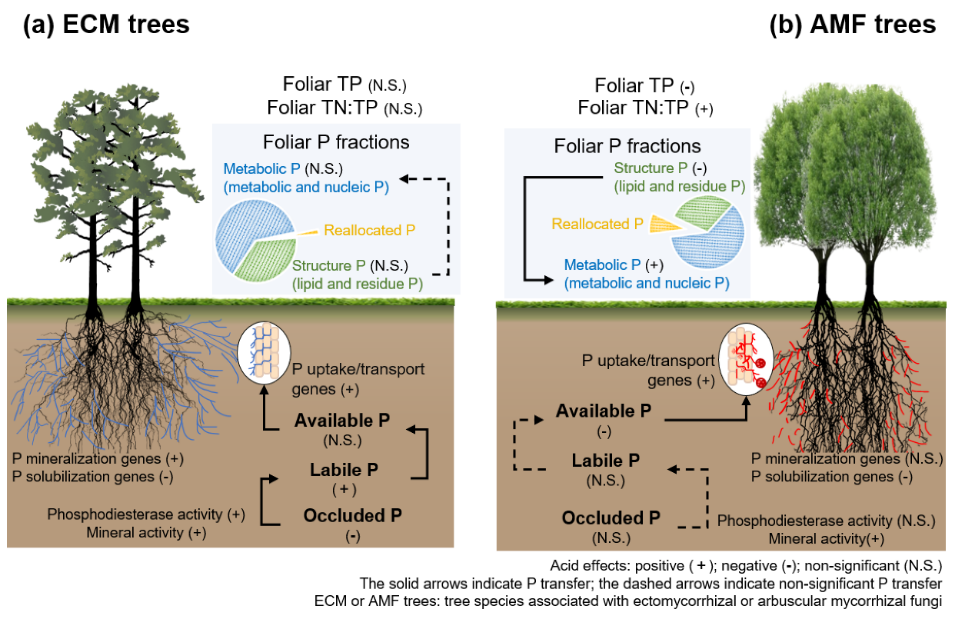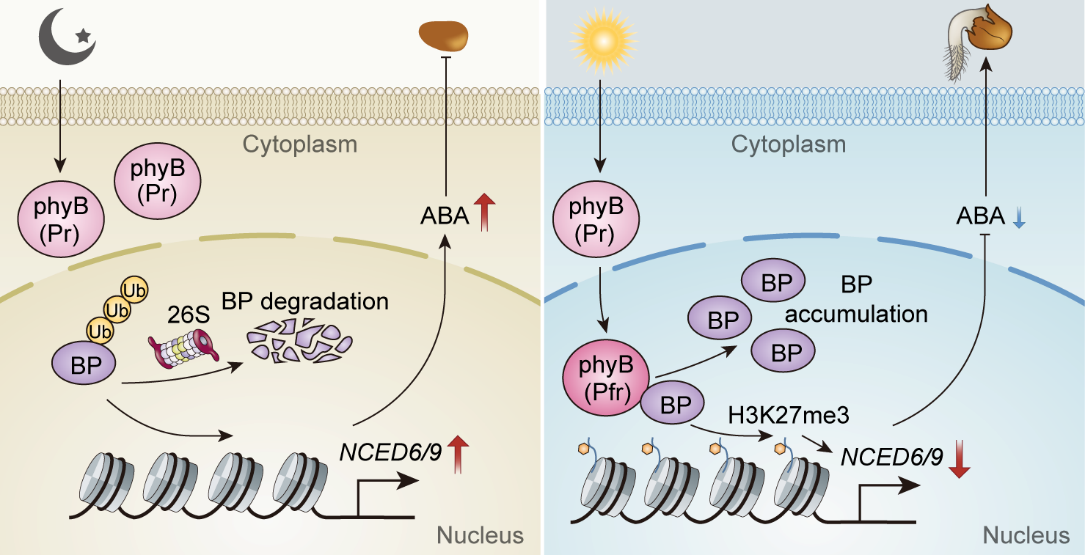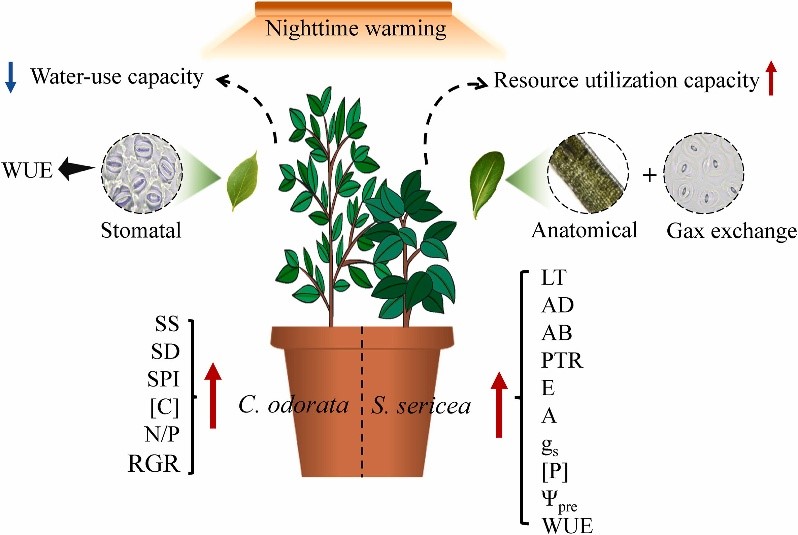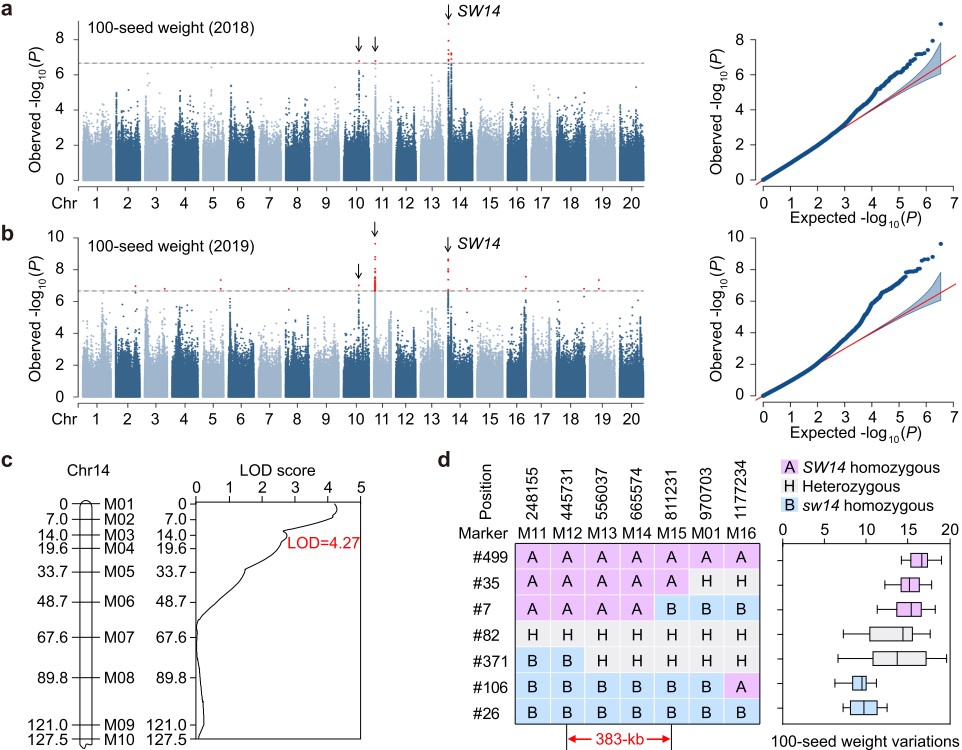News
-
2025-09-16Reveals divergent phosphorus adaptation strategies of tropical tree-mycorrhizal types after 12 years of simulated acid rainIntensifying acid rain is expected to exacerbate soil phosphorus (P) deficiency and reduce plant productivity in tropical forests. From the perspectives of both soil P acquisition and foliar P utilization, this study found the divergent strategies of tropical mycorrhizal trees to cope with acid-induced P deficiency. Acid rain is one of the most serious global environmental problems. Especially in southern China, persistent acid rain has led to severe soil acidification and the depletion of nutrients and base cations, thereby threatening ecosystem structure and function. Previous studies of Qi Deng's lab have shown that soil acidification after decades acid ...Read More
-
2025-09-16Tree-mycorrhizal types differ in their biomass response to nitrogen additionTree symbiotic associations with different mycorrhizal fungi (arbuscular mycorrhizal [AM] vs. ectomycorrhizal [ECM]) are a key predictor of woody biomass carbon (C) gain in response to nitrogen (N) addition.Therefore, shifts in the relative abundance of AM versus ECM trees could be a critical determinant of the future forest C sink under continu... A new study reveals that tree symbiotic associations with different mycorrhizal fungi (arbuscular mycorrhizal [AM] vs. ectomycorrhizal [ECM]) are a key predictor of woody biomass carbon (C) gain in response to nitrogen (N) addition. The study was published in Soil Biology and Biochemistry in 2025.From the South China Botanical Garden of the Chin...Read More
-
2025-09-14Roots dominate over extraradical hyphae in driving soil organic carbon accumulation during tropical forest successionPlant roots, rather than fungal hyphae, play the dominant role in soil carbon dynamics during tropical forest succession. In a two-year field experiment, we found that roots contributed nearly four times more to soil carbon accumulation by enhancing new carbon inputs and suppressing carbon losses from priming effects. A research team from the Restoration Ecology Group of the South China Botanical Garden, Chinese Academy of Sciences, in collaboration with scientists from the United States, Australia, and Spain, has made a breakthrough in understanding soil carbon sequestration in tropical forests. For the first time, the study systematically demonstrates that ...Read More
-
2025-09-14Polyploid Plants Maintain Heterostyly Through Ancient Genetic ArchitectureThrough genomic and transcriptomic analysis of the tetraploid distylous species Schizomussaenda henryi (Rubiaceae), this study identified an S-locus containing four hemizygous genes in the S-morph, with SchzAUX22 emerging as a key candidate regulating style length and filament growth via auxin signaling. The research demonstrates that the S-locu... Heterostyly is a floral polymorphism in which populations within a species contain two (distyly) or three (tristyly) floral morphs, characterized by reciprocal positioning of stigmas and anthers. This arrangement enhances pollination accuracy, reduces sexual interference, and promotes cross-pollination. Controlled by the S-locus supergene, heter...Read More
-
2025-09-05Scientists Discover Photoreceptor phyB Stabilizes the KNOX Transcription Factor BP/KNAT1 to Promote Light-induced Seed GerminationKNOX-type transcription factor BP/ KNAT1 plays a positive role in light-dependent seed germination. BP directly repressed the expression of ABA biosynthetic genes NCED6/9. The red/far-red light photoreceptor phyB interacts with and stabilizes BP in imbibed seeds. This work revealed that the phyB-BP-NCED6/9 cascade promotes light-initiated seed g... Recently, the team led by Professor LIU Xuncheng at the South China Botanical Garden, Chinese Academy of Sciences, published a research article titled “Phytochrome B stabilizes the KNOX transcription factor BP/KNAT1 to promote light-initiated seed germination in Arabidopsis thaliana”in the plant science journal Plant Communications.The study e...Read More
-
2025-09-01Scientists discover nighttime warming impedes invasion of Chromolaena odorata into tropical coral islandsThe nighttime warming caused by asymmetric global warming is mainly manifested as a reduction in the diurnal temperature range. Tropical coral islands in China, characterized as narrow diurnal temperature range, are more and more intensively affected by plant invasion. The research term conducted a nighttime warming(3°C) + sea sand experiment t... Global warming has become increasingly pronounced due to climate change and anthropogenic activities. The nighttime warming caused by asymmetric global warming is mainly manifested as a reduction in the diurnal temperature range. The previous studies suggest that nighttime warming can stimulate plant respiration, leading to a net loss of carbon ...Read More
-
2025-09-01Uncovers a novel regulatory mechanism of seed weight and quality in soybeanSeed traits are critical for soybean yield and quality. Here, the authors report a NF-YA transcription factor gene SW14 regulates soybean seed traits without affecting other agronomic traits by inhibiting GmLEC1-mediated transcriptional activation. Soybean (Glycine max L. Merr.) is a globally important oilseed and economic crop, serving as a vital source of high-quality protein for both human consumption and animal feed. Seed size and oil-protein content are key agronomic traits influencing soybean productivity. Identifying critical genes regulating soybean seed traits and elucidating thei...Read More







